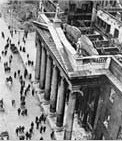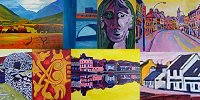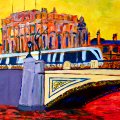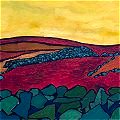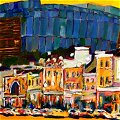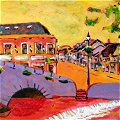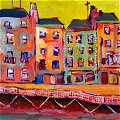Cycling Across America #70
Continental Divide
Part 70 of the Cycle-Across-America series. (Read from the start in Boston or see the full index)

It’s election day in the USA. And as America chooses its president, I cross the Continental Divide.
These excerpts are from the audio-taped sections of the journal, so again apologies for the rambling, the lack of structure, and for not having the time to edit it to a more manageable length.
8.30 in the morning, November the 5th. I’m running late as ever. This is, where is it? Lordsburg, New Mexico.
I’ve just watched a programme on an amputee running across America – only the 18th person to ever do so, and the first ever amputee. Certainly leaves you feeling quite …not inadequate, what ever the word is given that thousands upon thousands of people have cycled across it. And he was raising money for cancer.
The lunchtime in Ruidoso the day I left I asked my host, while his wife was at the salad bar, if they tried to meet most days for lunch. He paused for quite a while and then he said:
- Yes, why? Don’t you eat meat for lunch?Last night when I ordered my dinner I said:
-Can I have potatoes and beans please?
-Is that instead of the rice and the vegetables sir?
-No, that’s as well.And he got me a lot of things. He was very good, bringing me napkins, bringing me water several times, and Pepsi loads of times, and whatever else. At the end he says:
-Is there anything else I can get you tonight sir?
-No, you’re playing a blinder.Being Election day, it’s probably worth my while talking about the election. Dole last night spent 2 million quid on blasting all the networks with more infomercials. I watched some of them actually. He is certainly an interesting person – when it was just going through his own history.
Dole yesterday, was in Alamogordo. So he got quite a bit of coverage. They reckon between him being there and Gore in Las Cruces and somewhere else, it was an unprecedented presidential campaign in New Mexico. That hadn’t happened before.
I’ve noticed watching them in the last few days, from the David Frost interviews to whatever else, that they’ve felt kind of sorry for Dole – which I didn’t think would happen. Almost like he didn’t get a fair shot at it. He seems to be getting much more coverage in the last few days than Clinton even though Clinton is also going to a lot of States. So I’m wondering if the media feel sorry for him also.
Clinton’s voters are certainly keeping a low profile. By all accounts he’s going to easily win this election today but do you meet people who say they’re going to vote for Clinton? You don’t. It’s like they’re quite happy and they’re saying nothing. Maybe they’re embarrassed also. Or just smug perhaps.
I was thinking about them muscle problems I had in me legs coming from Mesilla up towards Hatch – the one in my right leg when it went. The previous day I’d gone over the pass – the San Agustin Pass – into Las Cruces. And going up there, well I normally ride with my – virtually my toe on the pedals, but I’d slip my feet fully into the toe-clips so it’s like the front half, a much larger area of the foot.
The effect of that is that you end up using the entire leg. Whereas the way I normally cycle you’re really only using from the knee down. So I was thinking it probably makes sense – I was suddenly using muscles I hadn’t used before on the trip. It was kinda gas as they’re – well it’s four thousand six hundred miles and twelve years of cycling, I’m quite possibly a bad cyclist.
That day I went past Fort Selden - where I changed the puncture by the Rio Grande - it was, like Fort Bayard yesterday, the home of the Buffalo Soldiers, and it was the childhood home of General MacArthur.
This is CMT. It’s so much better than the political nonsense that’s on the television at the moment. Yesterday when I watched it I saw Tricia Yearwood’s first single and the dreadful, dreadful haircut that she had.
Deming, the museum there, outside there’s a war memorial. It’s to those that died in Japanese war camps, particularly on the Bataan March. A lot of people from New Mexico were based in the Phillipines and surrendered. It was just after Pearl Harbour, the Japanese went in there, the Americans surrendered and they were taken prisoner. There was quite a lot of people from New Mexico and they had to go on this horrible march. And quite a few of them didn’t make it. It’s an upright flat stone with a picture of two prisoners of war carved on it, two emaciated bodies with watchtowers in the background and barbed wire around.
[The rest of this post, with mountains, mines, and Marcus Allen, is continued below the fold]
So yesterday what did I do? I cycled up through Bayard and Central, past the Chino Mines, Fort Bayard, and into Silver City. I was looking for the Pueblo ruins but I couldn’t find them. I started on the road to Fort Bayard and I could see it but then changed my mind. It’s now a medical centre so I saw no point in looking that closely.
The Chino Mines I could see quite clearly just from a corner and then I could see them I my rear view mirror one time so I turned around and looked at them – and they are HUGE. Indeed later in the day yesterday from about 30 miles away I could see above them the Kneeling Nun, which is a rock formation.
Silver City’s elevation at the city limits said 6,000. Without the wind of the previous day I got in there in ok time. At the bicycle shop I got 2 ‘stop flats’, liners for tyres – which I did not put in my tyres last night so I’m going off gambling again this morning. I also got an extra puncture repair kit so at least I have more of that but I can’t afford any problems today so - well we’ll see what happens.
They didn’t take credit cards so I had to run across the road to the bank. Their ATM didn’t take Visas so Rebecca said she’d do a transfer for me if we just go to Sheryl’s desk. And she needed some photo ID so I had to run back across the road and get me passport.
-A bicycle.
I said to her when she asked me what brought me to Silver City. So I told her what I was doing, spent a few minutes chatting and went back across the road. Your man told me about the thorns in the area since I was talking about flats - the 2 different types. The ones I’d been getting in West Texas. And the ones that you get here – the goat’s-head, pods which when you cycle over them they burst, and they’ve got little tacks that go in, and as you cycle around and around you drill them in and in until you get a small hole. That was what happened the last time. There was two of them together.These ‘stop flats’ have a guarantee that if you do get a puncture they’ll replace the ‘stop flat’ and give you a new tube. It won’t be much use to me but I just want them to cut out most of the things if they can.
So I wasn’t that disappointed in the end that I didn’t stay in Silver City - when I was looking at it. It’s the boyhood home of Billy the Kid, and the myth is that he killed his first person there. I wish they wouldn’t go on about Billy the Kid so much. There’s so much there and around in the area. The same goes for Lincoln County particularly, and other places I’ve been in.
I cycled past his – or the site of his - home. When I saw a café that looked great called Adobe Springs - because it was made out of adobe - I went in. It was nice. I had my best bowl of soup in the Southwest, indeed in America, a green chilli chicken chowder. It was delicious. As well as being a very creamy chicken with tons of green chilli in there, there was mushroom and carrots, and cauliflower and potato, and there was a lot of things in there.
Turned off State Highway 90, went down the Main Street, took a photograph or two. Although it’s a mountain town it’s not like Ruidoso because it’s surrounded by bushy hills and deserty hills, whereas Ruidoso is a thousand feet higher and up in the pine trees, and much more wooden. This is a rougher town, a mining town.
This is a newspaper. I’m just wondering about the mines here. It mentions Apache miners. It says “Indians harvested the copper that grew from the ground in fernlike pieces. And Mangas Coloradas, chief of the Apache nation following the death of Apache chief Juan Jose, sent arrows tipped with copper flying into gold-rush camps as his calling card after Indians were slain in 1837 by a howitzer Americans had concealed in the bush. Eventually the Indians cut off all supplies starving remnants of the camp, fled southward, and Santarita remained a ghost town until 1860.”
Then you had Spanish miners. “The Santarita del Cobra mine was over when the gold rush began. Lieutenant Colonel Jose Manuel Carasco, it is said, ignored his orders to destroy the Apache, and instead did a favour for one of the Indians who showed Carasco a piece of native copper and told him where he could find more. About 1800 Carasco and a party of 24 arrived in Santarita and opened a second open pit copper mine in territory that later became the United States. Only Lake Superior’s deposits were known earlier.”
Then you have American miners. “Trappers seeking beaver along the Gila River learned about the mine, Kit Carson wrote, storing a load of furs in an old mine opening in Santarita. Sylvester Patty decided to remain after making a deal with Ortiz, came close to buying the property, and left in disgust when a trusted employee absconded with 30,000 of his working capital.”
Then you had the end of Indian raids. “1872, Cochise, successor to Mangas Coloradas, agreed to move his tribesmen to selected reservations. Martin Beheas took over the old copper workings including one known as the Chino, or Chinaman. However Geronimo continued to war against the whites. While Geronimo was held captive from 1877 to 82, J. Parker Whitney brought Hays out and the Santarita continued to operate. Richer veins played out. At that time no one knew the low grade sulphide rock would become the foundation of one of New Mexico’s greatest industries.’ (From ‘This is Chino, Kennecot Coppercore – that’s where this information is coming from, Chino mines themselves.) ‘John Sully at the request of General Electric Company in 1904 studied the property for possible operation as an open pit mine. Though his report was favourable GE had lost interest. Sully persevered, and financial backing received in 1909 resulted in the Chino Copper Company mining start up and new mill at Hurley (where I was), nine miles away (it says here – oh yeah that’s from the mines, not from Silver City). Kennecot bought the mine in the thirties, built a smelter in ’39, added a fire refinery in 1942, a reduction mill in ’83, and a new smelter in ’84. Operations include blasting, loading and hauling at the mine with concentrating and smelting at reduction plant to produce copper almost one hundred percent pure. From the conservation side, we use water ‘til it wears out. We conserve valuable water by constantly reclaiming and recycling processed water at the precipitation plant, concentrator and power plant. In other words Chino people are experts at getting the squeal out of the pig.”
There’s one then on Tyrone, which is another mine as you come out of Silver City, which I passed. It’s quite amazing because the banks of the open pit mine slope down to the road. And you have great big piles of yellow golden rocks, and other piles of bronze rocks really – copper rocks I suppose – on top of the paler gravelly sand that forms most of it. I took a photograph of Tyrone from higher up because I climbed up out of Silver City, probably at least to six and a half thousand, maybe even to 6,700, 6,800.
Somewhere around Tyrone I entered the Gila National Forest. And most of the Gila National Forest, which houses the first wilderness declared in the States, is north of Silver City. This is an extra sub-section, not joined on to it. And it’s not a forest, quite simply. The trees are bush-like, and you can still see the sand in between them. So it’s less of a forest than the Bog of Allen.
It was here after several miles of going up and down (supposedly I was going more down but it was hard to tell), where I crossed the Continental Divide. It pretty much touched Silver City but I hadn’t crossed it. But here I did and it was 6,355 I think (feet). Several times I got a view back, back across to my east. I could see the smelter at Hurley, I could see the Kneeling Nun over at Chino Copper – the mines that I was talking about. But I could see all the mountains.
Cooke’s Peak looked fantastic, topping off its range with the desert down below it -which I’d cycled across. I could still see the Florida Mountains and Black Mountain in front of it and Red Mountain beside there. They’re like, almost like friends now when you’ve seen them for days, some of these things. They were great. They look more impressive in the distance I was thinking, a lot of them, than close up - like so many mountains. Even like the San Andreas Mountains I suppose. I was trying to think of which mountains didn’t. The Organ Mountains looked good from close up, and from afar. The Sacromento Escarpment looked much better close up. And okay they’re not in North America but the Alps look magnificent from any distance.
After I crossed the Continental Divide I went down a bit. Then I had to go up again, and I had to go up again on these hills and I thought it wasn’t fair. Surely it was going to be down hill all the way to the coast? Well, I knew it wouldn’t be, but it went on for a few more miles – best part of 10 miles, maybe about 7. And then finally the road just did a turn and there was a view.
I was looking across, like a basin area, the Alkali Flats, straight in front of me. That’s some of it anyway. I could just see mountains in every direction. Towards Lordsburg I could see 3 mountain ranges stacked behind each other, all very jagged. Up along the Arizona State Line there was lots more. You’re talking about the Pyramid Mountains immediately south of Lordsburg. The Enemeth Valley is behind that. The Peloncillo Mountains are behind that. The others are in Arizona. There’s peaks everywhere.
Now it was quite spectacular but not very good for photographs because the sun was coming in and everything was very hazy. But it did look quite awesome. In the distance I picked out the reflection of a car’s windscreen so I could work out where the road was going to go today. So I could see what I’m aiming for, something a bit like a gap, because that’s what I was having difficulty finding – I couldn’t see any way out of this fantastic wall of mountains that went around.
I might’ve be wrong though actually because looking at it now there’s a road that goes north to a town called Redrock and just stops there. I’d come through the Little Burro Mountains and the Big Burro Mountains. Burro Peak is over 8,000, and I came in between Night Peak and Hornbrook Mountain. They weren’t all that impressive going through them.
I passed, somewhere up there in the mountains, I passed, I had to hit the brake, I was going downhill actually, and I went back and I read about the Macomas Incident which was, if I remember rightly, a Judge Macomas and his wife killed by Apaches, Chirihuahua Apaches, led by Chato or something I think is his name, the Apache, and their 6 year old son was never found.
Also going up these slopes that would go on forever, I went for a drink in Dublin. Into the Palace Bar, with Marcus Allen, in the back room. And then the International Bar. That kept me occupied for a while.
Marcus Allen had just reached 110 running, rushing touchdowns, which is the equal first place. And 566 passes received, which is a record for a running back I think. Or whatever he is.
I saw my regular tarantula a day that I see. A hawk was on a stump. I don’t think it was a Soaptree Yucca, but on a stump quite close by the road, and I spoke to it and it flew up and around and landed again on it. Saw unfortunately another dead coyote. I would love to see a live one – they’ve all been dead.
I crossed into Hidalgo County as I dropped down out of the Gila National Forest, leaving Grand County behind. Something I also passed leaving Silver City now that I think of it, was a hitchhiker. And he used huge big bags, plastic bags all strapped to his back. He kept looking like he was going to fall over. Then he nearly did. So he asked me if I had any water. And I only had a tiny bit so I gave it to him because his need was definitely greater than mine.
In fact I didn’t drink at all from Silver City to Lordsburg. In fact I was throwing up, or coughing up, bringing up all the ice tea I’d been drinking in the Adobe Springs Café – which also mixed in with my main course was, what was my main course? I don’t know, I’ve a funny feeling it was Chicken Enchiladas, no it wasn’t it was Beef and Bean. Bean and Chicken, that’s what it was, it was Bean and Chicken Enchiladas.
It was good to give someone some water. It’s not often I’ve had a chance to meet somebody in a worse condition than I was. He had been hitch hiking for 2 days trying to leave Silver City. He was quite a few miles out of it, so I told him it was 35 miles to Lordsburg so whether he was going to walk it or not I don’t know but he couldn’t walk very fast with that weight.
The first thing I noticed in Lordsburg -you see the town on a slope as you come towards it, and you can see the Interstate at the back of it, so you got to kind of slightly climb up a slope towards things but, and I’m back down the far side of the Interstate -first thing I noticed was I passed a road called Lee Trevino Drive. Drive of course is fitting rather than Lee Trevino Street. It’s another Pacific Railway town. It’s the 3rd town I’ve been in which is a stop on the Butterfield Stage Coach, along with Mesilla and Deming.
I went to Cranberries, a restaurant attached to the Best Western. Unfortunately it was going to be dark so I couldn’t go to Shakespeare the ghost town which is only 3 miles away.
It’s the remains of a pioneer South Western town, a small settlement on the Stage and Overland trail to California, it grew in 1870 with a silver strike and a diamond swindle, to a town of around 3,000 people under the name of Roslyn City or the Burro Mines. After the diamond bubble burst it dwindled to perhaps 50 persistent miners. In 1879 the mine promoters changed the name of the town to Shakespeare, in your man’s honour, and under this name prospered as a mining camp until the 1893 Depression. During the 1908 to ‘32 mining boom the remaining buildings in Shakespeare were again occupied and the events during this period added considerably to the town’s reputation for lawlessness. Always a mysterious, secretive sort of town, it had no church, no newspaper, and no local law. Occasional free-for-all fights, and when these were serious enough some of the losers might be hanged. It’s older than any neighbouring town, and with its highly publicised mining boom has attracted many people, and so contributed greatly to the settlement of this part of the country. It’s been owned since ’35 by the Hill family and they’ve tried to preserve it.
This town was also a stop on that cross Atlantic flight by the Lindburghs. As well as Spearman, Texas. A bit of continuity there.
Forecast for the day? Clinton to win the election.
Read the Previous Entry (#69) in My Bicycle Trip Across America
Read more from my Cycle Across America

 Eolaí gan Fhéile:
Eolaí gan Fhéile: